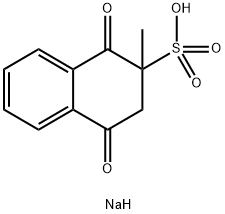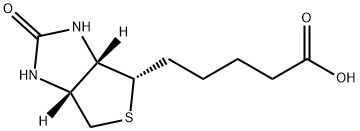Menadionesodiumbisulfite , 10mMinDMSO , 130-37-0
Synonym(s):
2-Methyl-1,4-naphthoquinone sodium bisulfite
CAS NO.:130-37-0
Empirical Formula: C11H11NaO5S
Molecular Weight: 278.25
MDL number: MFCD08063339
EINECS: 204-987-0
| Pack Size | Price | Stock | Quantity |
| 1ml | RMB159.20 | In Stock |
|
| others | Enquire |
PRODUCT Properties
| Melting point: | 121-124°C |
| storage temp. | -20°C |
| solubility | H2O: ≥50mg/mL, clear, colorless to faintly yellow |
| form | Solid |
| color | White to off-white |
| biological source | synthetic (organic) |
| Water Solubility | water: soluble 50mg/mL, clear, colorless to light yellow |
| InChI | InChI=1S/C11H10O5S.Na.H/c1-11(17(14,15)16)6-9(12)7-4-2-3-5-8(7)10(11)13;;/h2-5H,6H2,1H3,(H,14,15,16);; |
| InChIKey | JWNUEPMMANLFQO-UHFFFAOYSA-N |
| SMILES | O=C1C(CC(=O)C2=CC=CC=C12)(C)S(O)(=O)=O.[NaH] |
| EPA Substance Registry System | Menadione sodium bisulfite (130-37-0) |
Description and Uses
Menadione sodium bisulfite (MSB, also known as vitamin K3), is a crucial growth regulator mediating plant defense response. This substance is used clinically in China to treat hemorrhagic diseases caused by vitamin K deficiency and globally as a vitamin K supplement. This compound and its complex (MSBC) are water-soluble compounds. Menadione and the menadione sodium bisulfite complex are the sources of vitamin K activity in commercial laboratory rodent diets. Menadione possesses high biological activity, but its absorption depends on the amount of fat in the diet. Compared with Menadione, the menadione sodium bisulfite complex is more readily absorbed and is almost as active on a molar basis as phylloquinone. XTT, a tetrazolium salt, could converted to formazan in the presence of an electron coupling reagent such as menadione sodium bisulfite. The formed formazan does not need to be solubilized. Hence, the XTT test, a cytotoxicity evaluation method, is quicker and safer compared with MTT[1-2].
Menadione sodium bisulfite has been used:
- as a priming agent in tomato for improving salt tolerance
- to induce reactive oxygen species (ROS) in human lung epithelium BEAS-2B microtissues
- to induce endogenous superoxide production in mouse C17.2 neural stem cells
Safety
| Symbol(GHS) |   GHS07,GHS09 |
| Signal word | Warning |
| Hazard statements | H315-H319-H410 |
| Precautionary statements | P264-P273-P280-P302+P352-P305+P351+P338-P332+P313 |
| Hazard Codes | Xi,N |
| Risk Statements | 36-50/53-36/38 |
| Safety Statements | 26-61-60-24/25 |
| RIDADR | UN 3077 9 / PGIII |
| WGK Germany | 3 |




